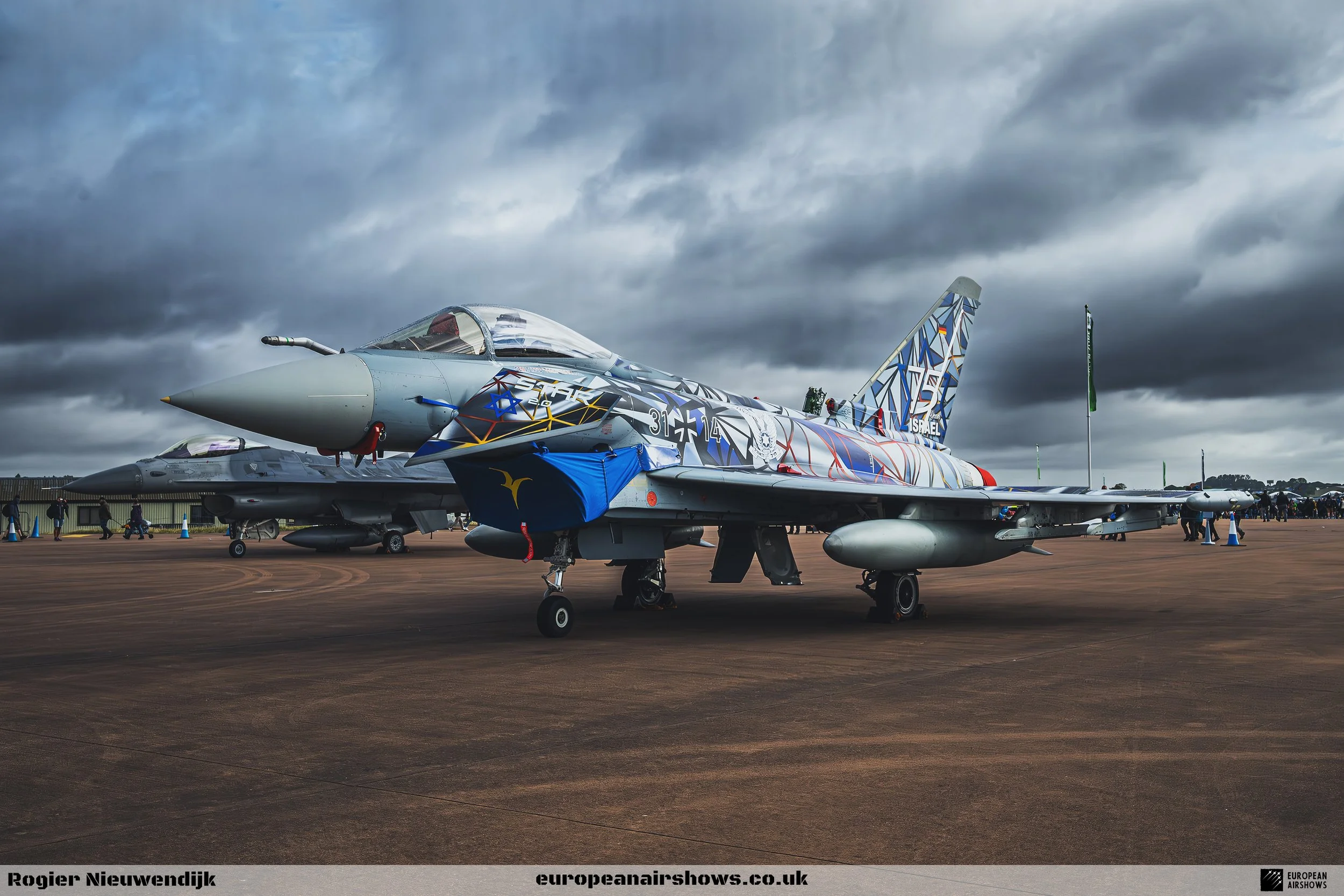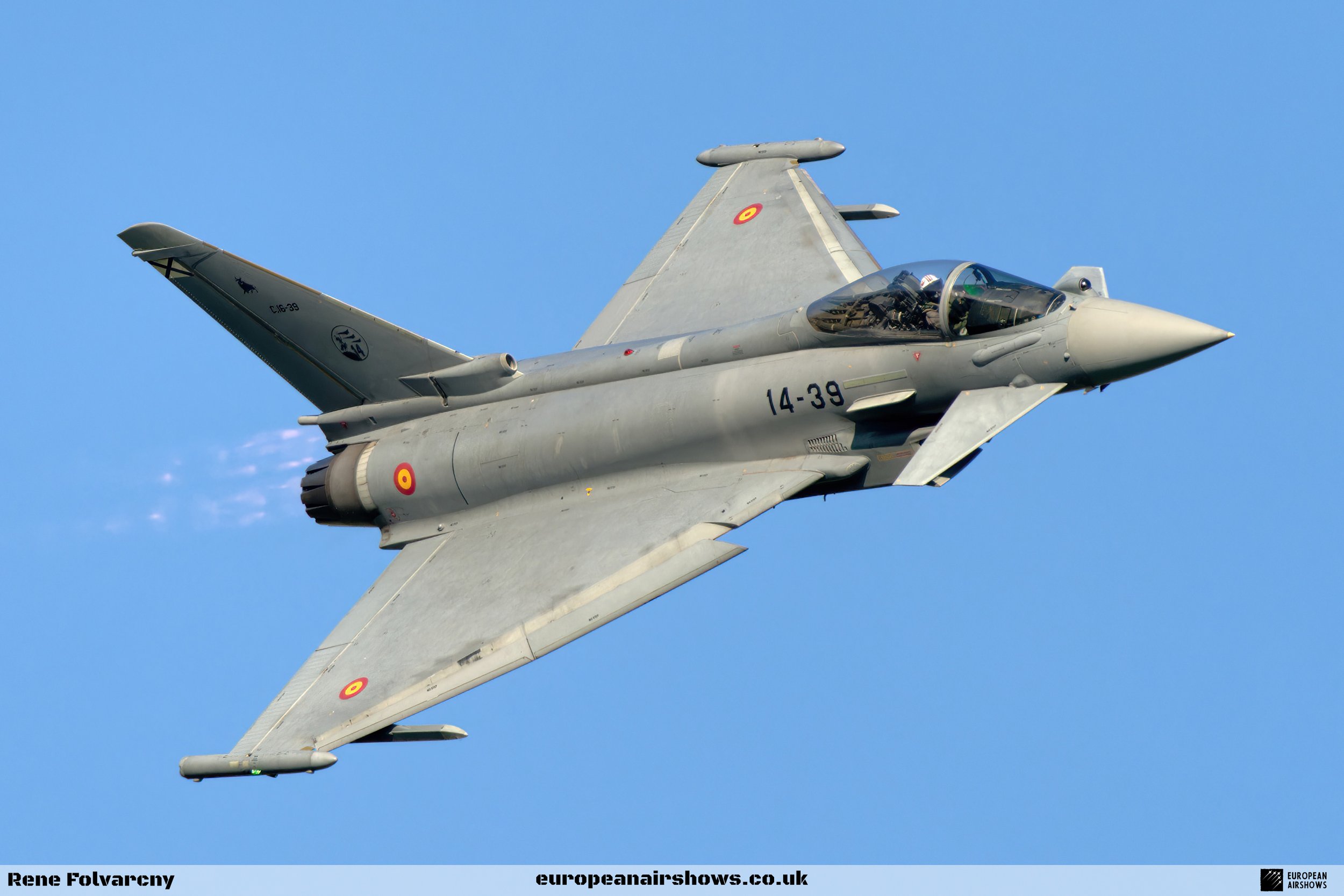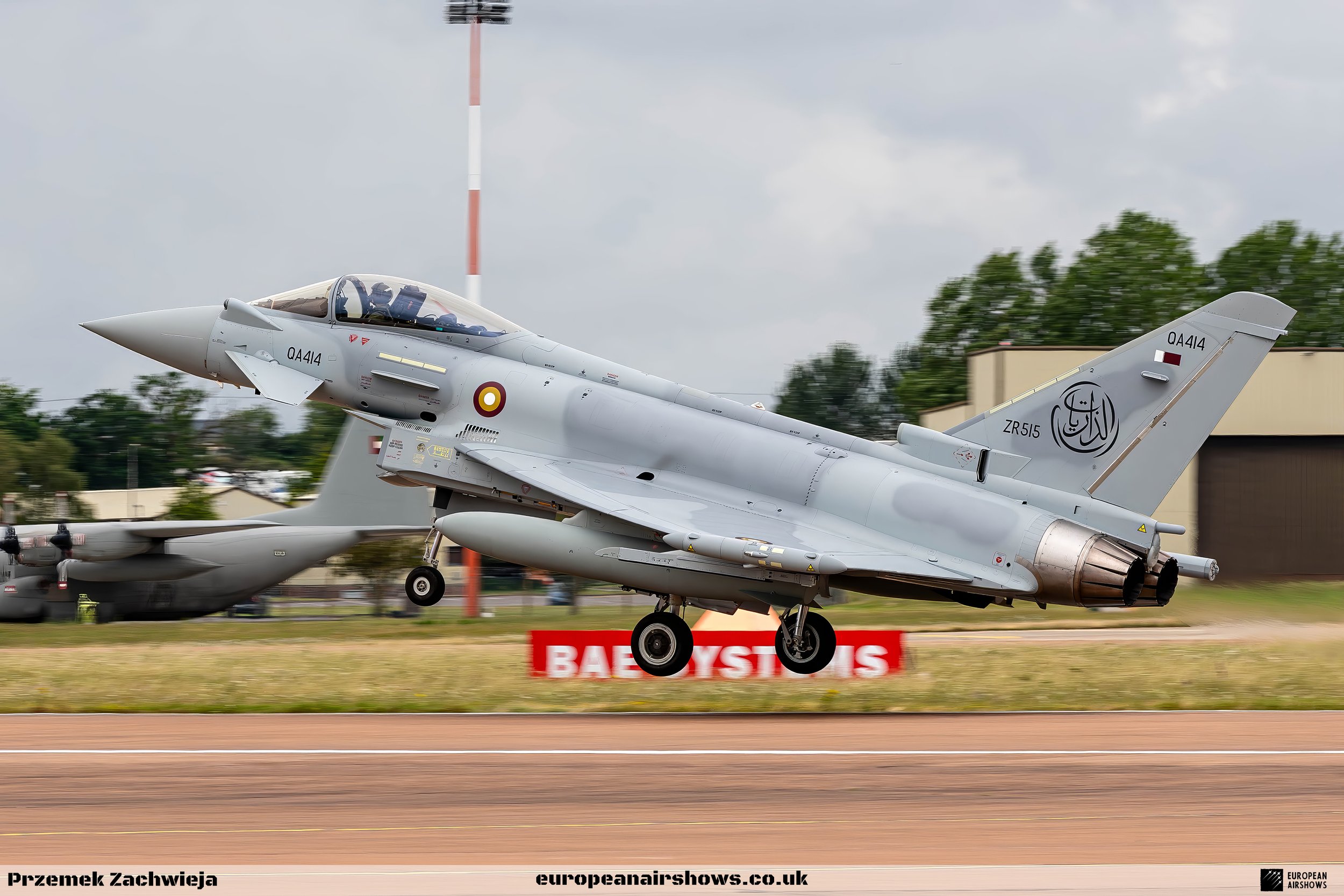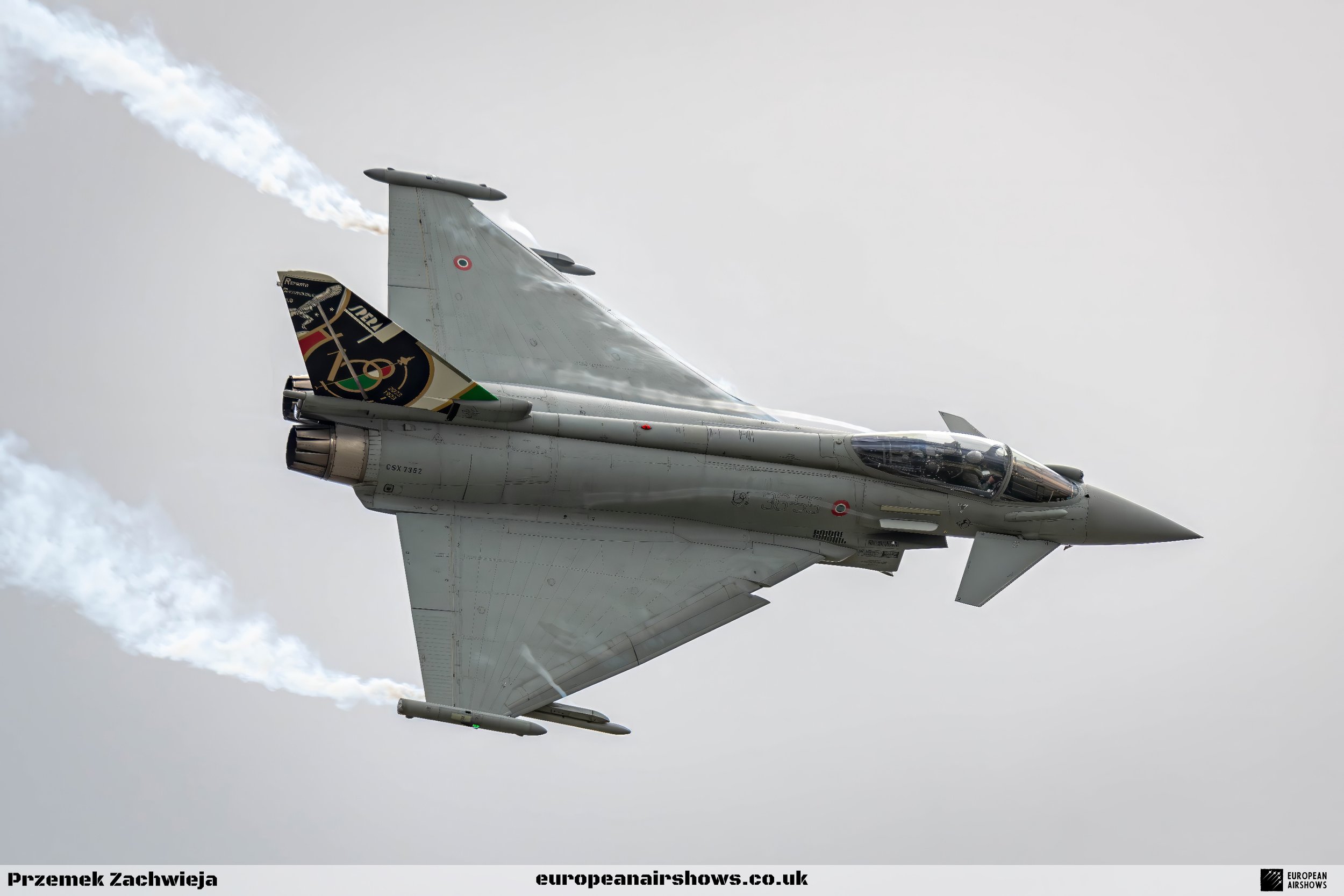
March 27 / Eurofighter Typhoon first flight
First flight 27 March 1994
Eurofighter Typhoon
The Eurofighter Typhoon, a name that conjures images of a storm tearing through the skies, is a fighter jet with a history as turbulent and thrilling as its moniker suggests. Born from the crucible of Cold War tensions and European ambition, this sleek, twin-engine marvel is more than just an aircraft—it’s a saga of innovation, rivalry, and the occasional bureaucratic dogfight. Picture a continent weary of relying on American and Soviet designs, dreaming instead of a homegrown champion to rule the skies. That’s where our story begins, in the late 1970s, when Europe decided it was time to take flight on its own terms.
Back then, the skies over Europe were a patchwork of aging warbirds. The British were zipping around in Harriers and Jaguars, the Germans were piloting Phantoms and Tornados, the Italians clung to their trusty F-104s, and the Spanish soared in Mirages. It was a logistical mess, a cacophony of engines and maintenance manuals that NATO could barely keep in tune. Across the Atlantic, the Americans were flaunting their F-15s and F-16s, while the Soviets countered with MiGs and Sukhois rolling off the assembly lines. Europe needed a unifier, a single fighter to replace this motley crew and stand toe-to-toe with the superpowers. Thus, the idea of a collaborative European fighter was born—a noble dream that would soon face the harsh realities of multinational teamwork.
The journey kicked off in earnest in 1983 with the Future European Fighter Aircraft program, or FEFA, which later morphed into the European Fighter Aircraft, or EFA. The UK, Germany, Italy, and Spain were the core players, each bringing their own wishlist to the table. France tagged along briefly but, true to form, peeled off to chase its own vision—the Rafale—leaving the quartet to forge ahead. The goal was ambitious: a supersonic, highly agile fighter that could dogfight with the best of them while also packing a punch against ground targets. The UK, with its legacy of nimble Spitfires and Harriers, demanded top-tier maneuverability. Germany pushed for versatility, eyeing a multi-role machine. Italy and Spain, meanwhile, wanted a modern, cost-effective replacement for their aging fleets. Balancing these demands was like trying to herd cats with jet engines strapped to their backs.
Behind the scenes, a consortium of aerospace giants took the reins. British Aerospace (now BAE Systems), Germany’s DASA (later folded into Airbus), Italy’s Alenia Aeronautica, and Spain’s CASA (also now Airbus) formed the Eurofighter Jagdflugzeug GmbH to manage the chaos. Funding was divvied up based on how many planes each nation planned to buy: the UK and Germany each ponied up 33%, Italy chipped in 21%, and Spain covered 13%. It sounded straightforward, but as production numbers shifted over time, so did the tensions. The design process was a battlefield of ideas—delta wings and canards won out, promising agility and stability, but every decision was a compromise hammered out over endless meetings and coffee-stained blueprints.
The first prototype, dubbed the Eurofighter 2000, roared into the sky on March 27, 1994, from Manching, Germany. It was a triumphant moment, the culmination of years of toil, but it also underscored how far the project had slipped. Originally slated to enter service in the late 1990s, the Typhoon was already lagging, bogged down by technical hurdles and political squabbles. Take the radar debate: the UK championed an advanced electronically scanned array (AESA) system, while Germany balked at the cost, favoring a cheaper mechanically scanned option. They settled on the CAPTOR radar, a mechanical system with AESA upgrades promised for later, a classic case of splitting the difference and hoping for the best.
The 1990s were a rough ride for the Eurofighter. The Cold War’s end had shifted the global chessboard, and critics wondered if this pricey bird was a relic of a bygone era. Costs ballooned, timelines stretched, and parliaments from London to Bonn grumbled. Germany toyed with slashing its order, while the UK faced scrutiny over every pound spent. Yet, the nations soldiered on, driven by pride, jobs, and the sunk-cost fallacy—scrapping it would’ve hurt more than finishing it. Even the name stirred drama. First called the EFA, then Eurofighter 2000, it finally became the Typhoon in 1998—a nod to its stormy power, though some Germans winced, recalling World War II bombings. Still, the name stuck, and the jet pressed forward.
Deliveries began in 2003, with the UK’s Royal Air Force taking its first Typhoon in June. By 2007, it was combat-ready, initially guarding the skies in an air defense role. Its CAPTOR radar and Defensive Aids Sub-System (DASS) made it a nightmare for intruders, while twin Eurojet EJ200 engines—each pumping out over 20,000 pounds of thrust—sent it screaming past Mach 2. Early models, known as Tranche 1, were air-to-air specialists, but the Typhoon was always meant to grow. Tranche 2 and beyond brought air-to-ground toys like Paveway IV bombs and Brimstone missiles, turning it into a true multi-role contender.
The Typhoon’s baptism of fire came in 2011 over Libya, during Operation Ellamy. British Typhoons flew combat patrols and rained precision strikes on Gaddafi’s forces, proving they could switch from sky cop to ground pounder with ease. Later, in Operation Shader against ISIS in Iraq and Syria, they cemented their reputation, weaving through contested airspace with lethal grace. Export deals followed, though not without hiccups. Austria grabbed 15 (later trimmed to 12), Saudi Arabia signed up for 72, and Kuwait and Qatar joined the club with orders in the 2010s. Total sales topped 600, a respectable haul for a jet that once struggled to sell beyond its home turf.
Technologically, the Typhoon is a stunner. Its airframe, a blend of carbon fiber and lightweight alloys, keeps it nimble yet tough. Those EJ200 engines give it a combat radius of over 600 nautical miles, while fly-by-wire controls and a delta-canard layout let it dance through the sky like a ballerina with afterburners. The cockpit’s a sci-fi dream—three big screens, a wide-angle heads-up display, and a helmet that lets pilots aim weapons just by looking. The CAPTOR radar, upgraded to CAPTOR-E AESA in later models, tracks targets miles away, while the PIRATE infrared system spots foes without a peep. Add in missiles like the Meteor and ASRAAM, and you’ve got a jet that’s as deadly as it is dazzling.
Of course, it’s not all smooth sailing. At over $100 million a pop, the Typhoon’s price tag draws gasps, and its two-decade gestation period raised eyebrows. Glitches—like ejection seat woes and software hiccups—popped up, though fixes followed. On the global stage, it’s duked it out with the Rafale, Gripen, and F-35, sometimes losing big contracts in India or Canada. Yet, its fans tout its agility, upgrade potential, and the jobs it sustains across Europe—thousands of engineers and factory workers owe their livelihoods to this bird.
The Typhoon’s story isn’t over. Upgrades are in the pipeline—new weapons, better electronics, maybe even AI to lighten the pilot’s load. Talk of a stealthier variant or unmanned version floats around, though nothing’s firm yet. For now, it’s set to fly into the 2040s, a mainstay of European defense. From its rocky birth to its combat-proven present, the Eurofighter Typhoon embodies a continent’s grit and genius—a jet that’s weathered storms, both literal and figurative, to claim its place in the sky. Next time you hear its roar, know you’re witnessing a piece of history, forged in ambition and soaring on the wings of unity.
Eurofighter Facts
Born from Cold War Rivalries: The Typhoon emerged from a rare alliance between the UK, Germany, Italy, and Spain in the 1980s, a time when Europe faced Cold War tensions. These nations set aside differences to build a jet that could counter Soviet threats, creating a symbol of unity that still flies today.
Wings That Defy Physics: Its canard delta wing design—featuring small forward wings paired with a triangular main wing—lets the Typhoon twist and turn like an acrobat in the sky. This setup makes it one of the most agile jets ever built, capable of outmanoeuvring opponents in dogfights.
Supersonic on a Whim: Thanks to its twin Eurojet EJ200 engines, the Typhoon can hit supersonic speeds without flicking on its afterburners—a rare trick called supercruise. Only a handful of jets worldwide can pull this off, saving fuel and staying stealthy while breaking the sound barrier.
A Radar That Reads the Battlefield: The Captor-E AESA radar isn’t just advanced—it’s a game-changer. It can track dozens of targets at once, see through electronic jamming, and even map the ground below, turning the Typhoon into a flying command centre.
Eyes That Aim Weapons: Forget joysticks—the Typhoon’s helmet-mounted display lets pilots lock onto targets just by looking at them. This sci-fi-inspired system tracks their gaze, slashing reaction times and making combat feel like a video game with real stakes.
Invisible to Radar (Almost): While not a full stealth jet, the Typhoon uses 70% composite materials—like carbon fibre and titanium—to shrink its radar signature. These lightweight, durable components make it sneakier than most rivals, even without a cloaking device.
From Peacekeeper to War Machine: The Typhoon has flexed its muscles in everything from patrolling NATO airspace to bombing targets in Libya and Syria. Its ability to switch roles mid-mission—say, from shooting down jets to striking ground targets—makes it a jack-of-all-trades in combat.
A Cockpit That Listens: Pilots don’t just fly the Typhoon—they talk to it. With voice-activated controls and a Hands-On Throttle And Stick (HOTAS) setup, the jet’s ergonomic cockpit feels like an extension of the pilot’s mind, cutting stress in high-stakes missions.
Armed to the Teeth: Picture this: 13 hardpoints loaded with Meteor missiles for air combat, Storm Shadow cruise missiles for distant strikes, and laser-guided bombs for precision hits. The Typhoon’s arsenal is so diverse it can take on almost any threat, anywhere, anytime.
Europe’s Gift to the World: This jet isn’t just a European star—it’s gone global. Countries like Saudi Arabia, Oman, and Kuwait have snapped up Typhoons, proving its prowess transcends borders and cements its status as a worldwide heavyweight in aviation.


































